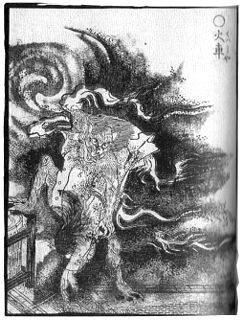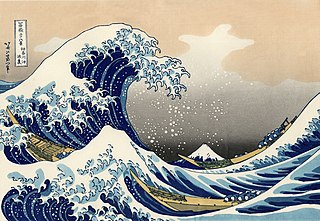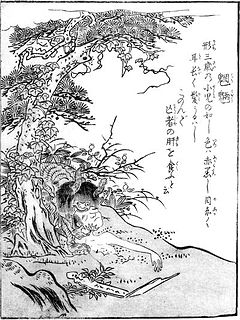
Nekomata are a kind of cat yōkai told about in folklore as well as classical kaidan, essays, etc. There are two very different types: the ones that live in the mountains, and the ones raised domestically that grow old and transform. It is often confused with Bakeneko.
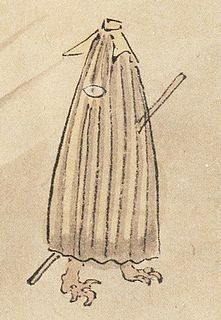
Kasa-obake are a mythical ghost or yōkai in Japanese folklore. They are sometimes, but not always, considered a tsukumogami that old umbrellas turn into. They are also called "karakasa-obake" (から傘おばけ), "kasa-bake" (傘化け), and "karakasa kozō" (唐傘小僧).
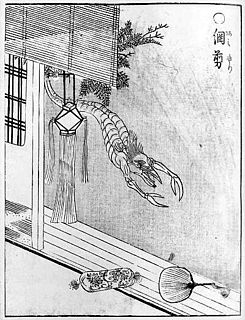
Amikiri is a Japanese yōkai depicted in the Gazu Hyakki Yagyō by Toriyama Sekien.

The bakeneko is a type of Japanese yōkai, or supernatural creature. According to its name, it is a cat that has changed into a yōkai. It is often confused with the nekomata, another cat-like yōkai, and the distinction between the two can often be quite ambiguous.

Funayūrei are ghosts (yūrei) that have become vengeful ghosts (onryō) at sea. They have been passed down in the folklore of various areas of Japan. They frequently appear in ghost stories and miscellaneous writings from the Edo Period as well as in modern folk customs. In the Yamaguchi Prefecture and the Saga Prefecture, they are called Ayakashi.
Tsurube-otoshi (釣瓶落とし) or tsurube-oroshi (釣瓶下ろし) is a yōkai told about in Kyoto Prefecture, Shiga Prefecture, Gifu Prefecture, Aichi Prefecture, Waka Prefecture, among other places. They are said to drop from above the trees and attack, and even devour humans.

Satori in Japanese folklore are mind-reading supernatural monsters ("yōkai") said to live within the mountains of Hida and Mino.

Mikoshi-nyūdō is a type of bald-headed yōkai "goblin" with an ever-extending neck. In Japanese folklore and Edo period (1603–1868) kaidan "ghost story" texts, mikoshi-nyūdō will frighten people who look over the top of things such as byōbu folding screens. The name combines mikoshi 見越し "looking over the top ; anticipation; expectation" and nyūdō 入道 "a (Buddhist) priest; a bonze; a tonsured monster".
The kinoko (木の子) is a yōkai told in legends of the Kinki region.
Yosuzume are bird yokai, the knowledge of which are handed down within the Hada District, Aichi Prefecture towns of Tanokuchi, Tomiyama, in Kitagawa, Aki District, in Minamiuwa District, Ehime Prefecture, and in other places.
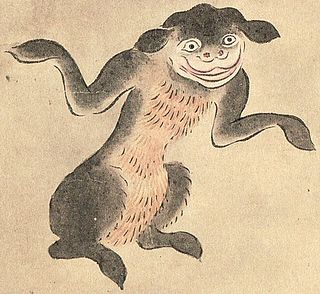
The yamabiko (山彦) is a mountain god, spirit, and yōkai in Japanese folklore. Literally translated, "yamabiko" means "echo." It is the yōkai responsible for the natural phenomenon in mountains or canyons. Living deep in the mountains, direct encounters with the yamabiko are rare. Often they are heard, but never seen. The small and elusive yokai wasn't officially classified until the Edo period in Japan. Instead the bizarre noises coming from the mountain were attributed to a natural phenomenon, like birds, and not given any spiritual significance. It is usually depicted with gray fur, peach-colored belly, floppy ears, large grin, and arms outstretched as though it is caught mid-shrug.

Ikuchi is a yōkai of the sea in Japanese legend. It is described in Tankai (譚海) by Sōan Tsumura and in Mimibukuro by Negishi Shizumori among other written works of the Edo period.

Yamajijii (山爺) or Yamachichi (山父) is a type of yōkai told about in Japan.

Hitotsume-nyūdō is a yōkai of Japan that has the appearance of an ōnyūdō that has only one eye
Shidaidaka (次第高) are a yōkai of the Chūgoku region.

Tenome is a Japanese yōkai that appeared in the Gazu Hyakki Yagyō by Toriyama Sekien.
The sunekosuri is a Japanese yōkai. Stories are told of it in Okayama Prefecture and is said to get in the way of people's paths as they walk.

Umi zatō (海座頭) is a Japanese yōkai that in the Gazu Hyakki Yagyō by Toriyama Sekien and in various emakimono such as the Matsui Library's Hyakki Yagyō Emaki.

Yamawaro or yamawarawa (山童) is a yōkai that appears in mountains that is told about in Western Japan, starting in Kyushu. Sometimes it is said that they are kappa who have come to dwell in the mountains. In the Ashikita District, Kumamoto Prefecture, in addition to "yamawaro," it is also called "yamawarō", "yamamon", "yamanto", "yaman wakkashi", and "yaman ojiyan". Also, in the Kuma District of the same prefecture, they can also be called "yaman-tarō" (山ん太郎) or "yamanbo" (山ん坊).




